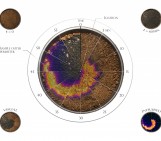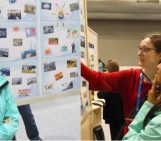
Many wild animals make extraordinary long-distance journeys, whether by land, by air or even by sea. Ancestral, and even some modern, humans have likewise undertaken equally impressive odysseys across and between continents. In order to highlight these “epic journeys,” four different research projects were presented during an EGU press conference held on Wednesday.
During the virtual presentations, Oliver Lamb, a postdoctoral researcher from the University of North Carolina at Chapel Hill, briefed reporters from around the world on the first results of a study that used low-cost sensors to detect the vocalisations and footsteps of individual African Bush Elephants in order to monitor their movements in South Africa. As he said, “wild elephants are exposed to a lot of threats,” so keeping a track of these animals is more than necessary. And this is exactly what the Raspberry Shake & Boom seismo-acoustic monitors are capable of, as the devices are able to record what Lamb described as “the bumping of the elephants” up to 400 meters away.
Philippe Gaspar, an oceanographer from Mercator-Ocean who also spoke at the press conference, told the journalists in attendance that “we only have seven sea turtles species on Earth, and all of them are classified as vulnerable, endangered or critically endangered.” Gaspar and his team model the dispersal of leatherback hatchlings and juveniles in the oceans, where he says they are especially vulnerable. Although many coastal countries have spent millions of Euros to protect sea turtles while they’re nesting on beaches, he pointed out that “we also need to protect the sea turtles at sea!” Gaspar and his collaborators hope their model will help preserve the species by informing fishermen of the turtles’ locations so that they can avoid fishing near them.
Eileen Eckmeier, Professor in the Department of Geography at LMU Munich, spoke about how variability in soil nutrients may help drive migrations of more than a million wildebeest and hundreds of thousands of zebras and antelope in the East African Serengeti. As Eckmeier explained it, her research shows that “geochemical variation together with continuous soil formation created a patchwork of soils with different nutrients.”
The fourth press conference participant, Lisa Thalheimer, a PhD student from the Environmental Change Institute in the University of Oxford, spoke about human, rather than animal, migrations. Her presentation introduced journalists to Forecast-based Financing, which she defined as forecasting that “enables access to humanitarian funding for pre-disaster action, based on climate and weather forecasts, combined with risk analysis.” Thalheimer’s research is based on the fact that new displacements are occurring more frequently due to droughts, due to floods, and due to heat, and she emphasized that by studying this phenomenon, scientists can predict human migration due to climate displacement and use this information to increase the effectiveness of much-needed humanitarian aid. Her key focus, “anticipation instead of reaction,” succinctly summed up the importance of all the presenting researchers’ approaches to studying migrations.




